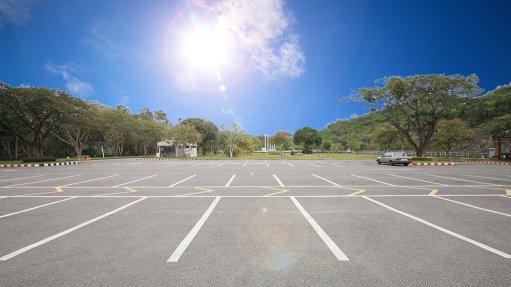
DIG A LITTLE DEEPER The environmental aspects of concrete parking lots, should not be overlooked
Concrete offers several major advantages when building parking areas, says industry body The Concrete Institute (TCI) MD Bryan Perrie.
He states that the maintenance costs of concrete parking areas are minimal, with only some joint sealing and cleaning usually required yearly.
“Asphalt parking surfaces, on the other hand, need to be treated every few years and totally resurfaced at least every ten years. Such maintenance work can be very disruptive to the operations of a commercial shopping complex or office block.”
He adds that several studies in the US have shown that, over a typical 20-year life span of a parking area, concrete required very little maintenance, compared with the maintenance required for an asphalt parking lot, which ended up being as much as 80% of the initial construction cost.
Additionally, the lighting of the parking lot can be reduced when using light-coloured concrete surfaces, as an estimated three out of ten light fixtures can be eliminated without losing the level of lighting when using light-coloured concrete surfaces.
“With crime being a constant problem in South Africa, lighter-coloured concrete parking lots create safer storage for cars while reducing energy costs,” Perrie explains.
He notes that lighter-coloured concrete also lowers temperatures in parking areas during the hot South African summers and, by eliminating the ‘heat-island effect’, can even lower cooling costs for adjacent buildings.
Further, concrete parking lots – particularly those with brushed finishes – are more skid-resistant and allow for easy installation of so-called rumble strips. Concrete pavements also do not rut or develop potholes when carrying heavy loads.
He highlights that the environmental aspects of concrete parking lots should also not be overlooked.
“The runoff is low in toxicity and cooler than those from asphalt surfaces. Moreover, permeable interlocking concrete pavements substantially reduce runoff, which is now increasingly enforced through legislation overseas. Additionally, the concrete mix used for parking lots can include recycled materials such as slag, fly ash and recycled concrete.”
Perrie also points out that concrete pavements are built in one layer – usually on a subgrade of compacted earth – whereas asphalt pavements require an additional gravel or crushed-stone base. All these, he says, are practical considerations when using concrete for parking areas.
Moreover, the selection of concrete to pave a parking lot offers the designer unlimited choices of texture, pattern and colour for aesthetic appeal, which improves the appearance of the lot. Colour can also be used to identify specific areas for buses, trucks and visitors’ vehicles, as well as directional signs for pedestrians.
The parking lots can also be blended with adjacent greenbelts or equipped with water features.
“Parking areas are more than just surfaces for cars. They serve as attractive welcome mats for offices, sports stadiums, airports, shopping centres, besides others. They also demonstrate quality to visitors – even before they walk through the front doors,” Perrie enthuses.